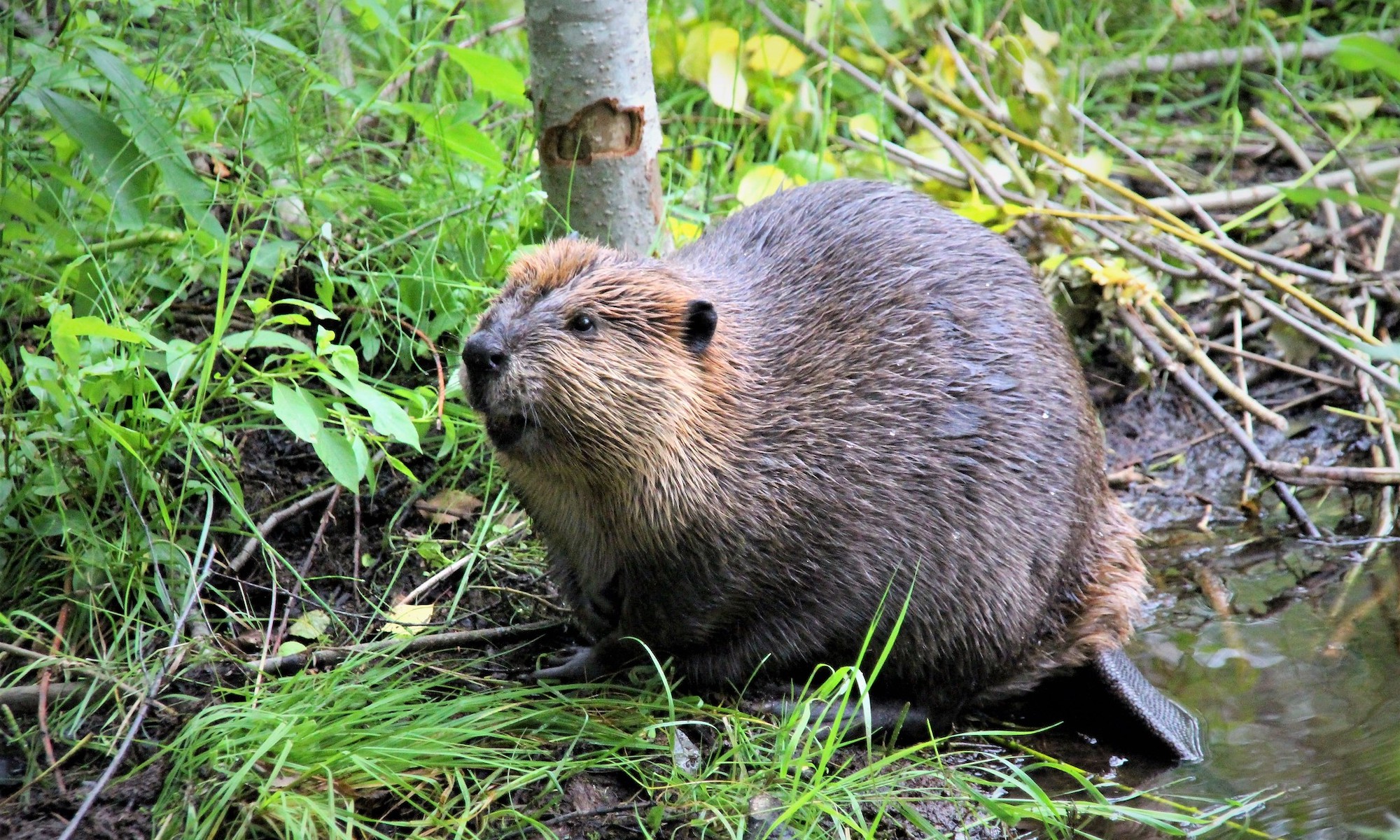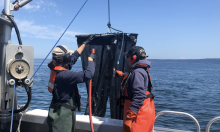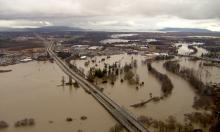“It’s not a huge dam, but it’s holding back a couple feet of water,” says Ariana Winkler, eyeing a modest pile of mud and sticks just above a wooden footbridge on a tributary of Hulbert Creek, which feeds into Ebey Slough in Snohomish County. The dam is likely the handiwork of a family of beavers who live in a lodge in an adjacent, larger pond that was built when the surrounding neighborhood of modest two-story suburban houses was developed.
The industrious rodents probably constructed this auxiliary dam to create deeper water that provides easier access to food and other resources as well as protection from predators, says Winkler, a program manager with the Snohomish Conservation District (SCD) who coordinates the Living with Beavers program.
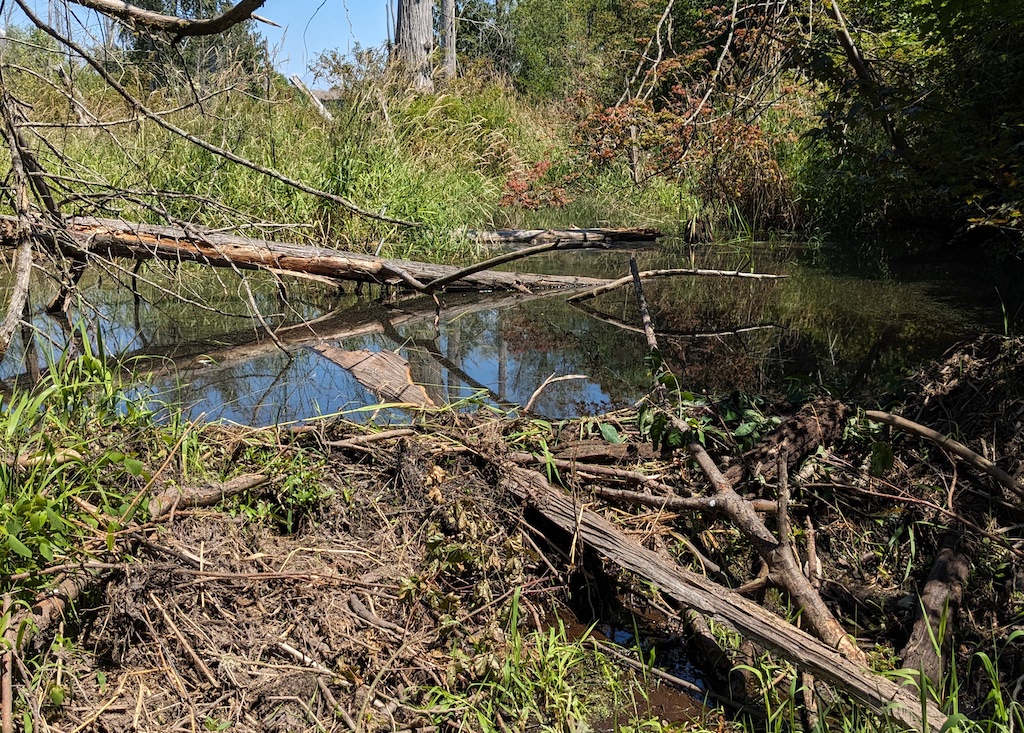
A beaver dam on a tributary to Hulbert Creek in Snohomish County, Wash. Photo: Sarah DeWeerdt
The program, which began in 2017, aims to educate property owners about the benefits of having beavers around and promote alternatives to beaver dam removal – which in the past has been the default response to beaver activity in many rural and semi-rural areas of Washington State.
Winkler, clad in black rubber boots, brown work pants, and a black SCD t-shirt, her auburn hair bundled into a thick braid, has been on the job for about a year. Her role is to meet with property owners and plan the best management strategies to enable people and beavers to coexist in a given location. Today’s site visit follows a series of conversations with the neighborhood homeowner’s association that manages the greenbelt within which this beaver dam is nestled.
Puget Sound recovery strategic initiatives
This article was commissioned by the Habitat Strategic Initiative Lead (HSIL), a cross-agency team co-led by the Washington Departments of Fish and Wildlife and Natural Resources, as part of a grant to the Puget Sound Institute to synthesize and communicate on 100 grant awards made by the HSIL between 2016-2020 with EPA Puget Sound Geographic Program funds.
About HSIL
The 2012-2013 Action Agenda for Puget Sound developed by the Puget Sound Partnership established three initiatives to tackle multiple issues critical to Puget Sound recovery:
- habitat protection and restoration
- shellfish bed protection and recovery
- stormwater pollution prevention.
To manage this effort, agency and institutional partners assembled into three Strategic Initiative Lead (SIL) teams, charged with bringing people and ideas together to improve the water, habitat, and communities. Read more about the Puget Sound Recovery Program.
The role of HSIL is to implement plans that improve the health of the rivers, forests, shorelines, and estuaries that make up Puget Sound.
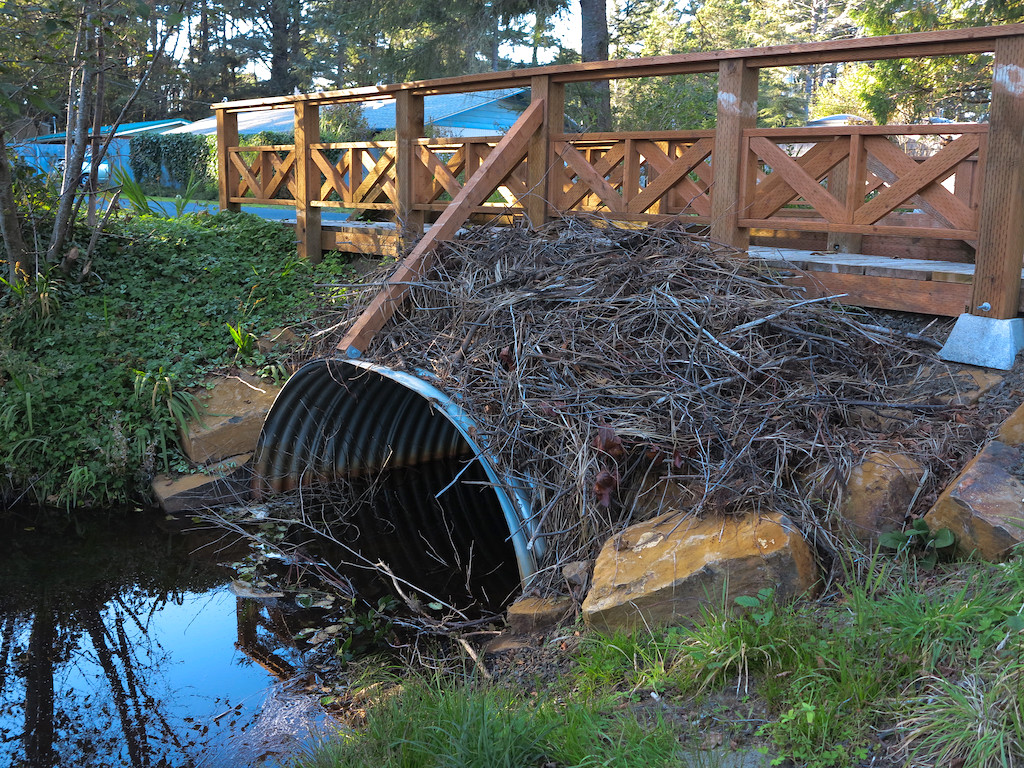
Beavers dams built across culverts can cause roads to flood. Photo: Alex Derr (CC BY-NC-SA 2.0)
Sharing wetlands
Beavers are increasingly recognized – even celebrated – for their contributions to wetland and watershed health. “Beaver habitat just provides incredible benefits to the ecosystem,” says Winkler’s boss, Kristin Marshall, habitat restoration and floodplain resilience program director for SCD.
Beavers benefit hydrology, biodiversity, climate change resilience, and salmon recovery in western Washington’s watersheds. Their dams help slow the flow of water through stream systems, diminishing flooding during the wet months of winter and spring and increasing streamflow during the region’s increasingly warm and dry summers. Water backed up behind a beaver dam seeps into the soil and replenishes groundwater stores, reducing water temperature downstream. And by creating complex wetlands and adding woody debris to streams, they provide crucial rearing habitat for salmon, especially coho.
But beavers can also play havoc with human endeavors. They sometimes build dams across culverts – they favor narrow points of streams for their construction work – causing roads to flood. Other dams flood yards, driveways, or agricultural fields. The standing water in a new beaver pond may kill trees and other plants. Or the animals choose vegetation that people really want to preserve – fruit trees, or native plants installed as streamside buffers in salmon restoration projects – for their building materials.
“They want to be in the same places that we want to be, really,” says Jennifer Vanderhoof, a wildlife biologist with King County and president of Beavers Northwest, a nonprofit that provides beaver management services in western Washington and SCD’s collaborator on the Living with Beavers program. “And after us humans, they’re the species that can affect their landscape the most.” It can be tough sharing the landscape with another ecosystem engineer – a sentiment that might ring true to beavers, too.
Prior to European settlement, many of the riversheds that drain into Puget Sound would have had thousands of beaver-created wetlands and the beavers to go with them. But widespread trapping nearly extirpated the animals from the area that is now Washington State by the mid-1800s. So when the settlers later built roads and towns and laid out the boundaries of farm fields, they did so in an artificially beaver-less landscape.
But in the last 20 years, what Vanderhoof calls "the beaver trifecta" — a near-cessation of trapping due to both a state ban on body-gripping traps, a broader collapse in the price of beaver pelts, and the Endangered Species Act listings of multiple Puget Sound populations of salmon that triggered stream restoration efforts — has enabled beaver populations to bounce back in many areas.
Meanwhile, expanding development has brought more people living in closer proximity to beaver habitat, as well as an expansion of pavement that sends more stormwater runoff through local streams. Sometimes, beavers get blamed for flooding related to urban development, or dams that previously didn’t interfere with human infrastructure begin to do so with more runoff entering the system, Winkler says.
The small beaver dam on the Hulbert Creek tributary is a perfect illustration of these forces. It sits in a larger landscape of newly laid asphalt and half-finished traffic circles and is surrounded by an amalgam of native and invasive vegetation that reflects the area’s position at the fringes of urban growth: salmonberry and Himalayan blackberry, salal and creeping buttercup. The homeowner’s association reached out to SCD last year because of flooding on the greenbelt’s walking trails.
“This historically hasn’t been flooded,” says Sara Rocero, poking at the muddy path with the toe of her sport sandal. Rocero, a habitat restoration project manager with SCD who has joined Winkler for today’s site visit, lives nearby and enjoys walking on the greenbelt paths herself; she says beavers have been in the area since at least 2015. Today, the ground sucks at our shoes as we walk, despite the dry, sunny weather. “Beavers but also an increase in development creating more impervious surface directs more water into this area,” she says.
Funding the work
The grant that gave the Living with Beavers program its start is one of roughly 90 distributed by a cross-agency group called the Habitat Strategic Initiative Lead (HSIL), a collaboration between the Washington Department of Fish and Wildlife and the Washington Department of Natural Resources. The group's purpose is to distribute grant funds provided by the federal Environmental Protection Agency, including funds for estuary and floodplain restoration in Puget Sound. HSIL grants emphasize Integrated Floodplain Management (IFM), an approach to managing floodplains that is cooperative and inclusive. The idea is to find projects that can benefit fish, farms, and flood control all at the same time, rather than pitting different stakeholders against each other as has often happened in the past.
The Living with Beavers program is not formally considered IFM, but it illustrates an important aspect of the approach, which is bringing together groups who may normally have contentious or even antagonistic relationships – in this case, property owners and beavers. The conservation district functions as the beavers’ proxy; the beavers themselves communicate mostly through their works.
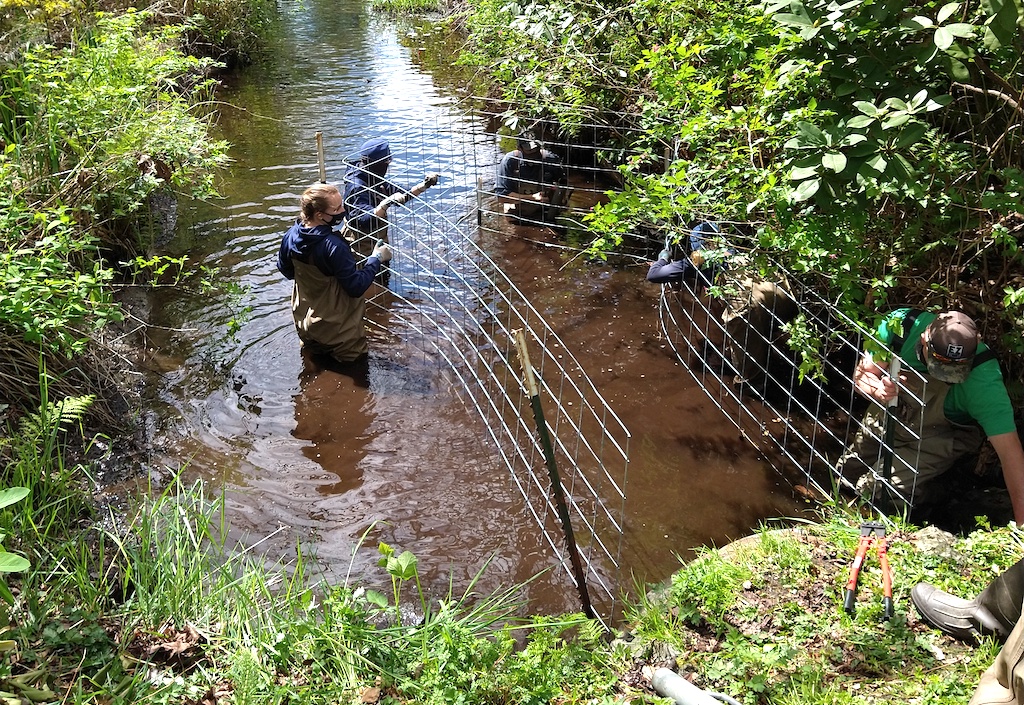
Exclusion devices, like the one seen here on Stitch Creek in Lake Stevens, being installed in front of a road culvert, can prevent problems caused by beavers. Photo: Courtesy Snohomish Conservation District
HSIL grants often support difficult-to-fund activities such as relationship building, planning, and preliminary work: vital to the eventual success of restoration efforts but disfavored by most other funding channels.
In this realm the original Living with Beavers program grant, which ran from March 2017 through November 2018, was a wild success. It resulted in the development of social media posts and outreach materials, six workshops in various cities to help landowners learn more about the benefits of beavers and the alternatives to dam removal, and a tour of a property where beavers are present so that interested landowners could see coexistence strategies in action.
“There is a real demand for these services, and it seems that the limiting factor for completing this work is simply making people aware that the services exist, and may provide benefit to them and the environment,” Marshall and Alex Pittman, who at the time worked for SCD and is now a watershed steward with Snohomish County, wrote in a 2019 report about the program. “We noticed a real spike in site visit requests, and subsequent project opportunities, each time we completed an in-person landowner workshop or when local media published an article about the project.”
The program is now part of SCD’s Making Space for Water Initiative; a grant from the state Streamflow Restoration Program will continue to provide funding through 2024.
Finding solutions
When beavers are causing problems for landowners, there are several ways to intervene. Trees and shrubs can be enclosed in cages to prevent the animals from cutting down the vegetation. Beaver dam management strategies are designed to get more water to flow through the dam – ideally without the beaver noticing or at least without being able to easily do anything about it. This lowers the level of the pond and reduces flooding behind the dam, making it easier for people to tolerate the beavers’ presence.

Beaver dam before and after notch exclusion fencing was installed to promote water flow and manage water levels on a tributary to Stevens Creek in Lake Stevens. Photo: Courtesy Snohomish Conservation District
In cases where human-beaver coexistence isn’t possible – for example, if they can’t be persuaded to forgo dam building across a culvert or when they take up residence in a detention pond – SCD works closely with the Tulalip Tribe’s beaver relocation program. The tribe humanely traps beavers in suburban areas and releases them in parts of the upper Snohomish watershed to improve fish habitat and water storage.
At the greenbelt site near Hulbert Creek, Winkler is planning to install a device known as a notch exclusion fence on the dam. Her team will remove some material from the center of the dam – creating a “notch” in it – and then build a big cage around the notch so that the beavers can’t easily access it to repair it. Today, she aims to get a better sense of where the dam’s crest is, how much space there is to install the device, and how much material – and therefore grant money – will be necessary to build it.
Beavers can be unpredictable. They might respond to a notch exclusion device by doing nothing, by jamming sticks into the mesh to restore the higher water level, by abandoning the dam, or even by building a new dam just downstream – on which a new device must often also be installed.
“We don’t know what beavers are going to do,” says Winkler. “And I think beavers are smart and adaptively manage their dams themselves.”
But the dynamic and often iterative nature of beaver dam management also has its upside. As SCD staff build relationships with landowners through beaver work, this can become a gateway to other habitat restoration efforts such as adding streamside buffers or a rain garden, Marshall says.
Sometimes, after learning more about the benefits of beaver wetlands and being reassured that the beavers on their property aren’t threatening the ecology or the infrastructure, landowners opt not to intervene at all. “We’ve seen a number of property owners who really shifted their thinking and then those dams create really nice, long-standing water storage,” Marshall says.
And despite the challenges, beaver management work can be a welcome respite from the uncertain slog of conventional habitat restoration. “A lot of my time and energy is spent on coming into degraded situations and figuring out how to turn them around,” Pittman says. But with beaver dams, “we’ve got this awesome ecosystem feature that’s providing all sorts of benefit to the site and everything downstream of it. And all we need to do is figure out if there’s a way that we can modify things slightly so that the landowner or infrastructure can coexist with it.”
This article has been funded wholly or in part by the United States Environmental Protection Agency under assistance agreement PC-01J22301 through the Washington Department of Fish and Wildlife. The contents of this document do not necessarily reflect the views and policies of the Environmental Protection Agency or the Washington Department of Fish and Wildlife, nor does mention of trade names or commercial products constitute endorsement or recommendation for use.
